Getting your Trinity Audio player ready...
A surgical instrument, the size of a dinner plate, was discovered inside a woman's abdomen in Auckland, New Zealand, a year and a half after she underwent a cesarean section surgery.
Read more:
The woman had undergone a C-section in 2020 due to concerns about a partially detached placenta. Afterward, she endured severe abdominal pain for months and sought medical attention to determine the source of her discomfort.
Among other tests, the woman had X-rays of her abdomen, but they revealed no abnormalities. When her pains intensified about a year and a half after childbirth, she was referred to a radiology department, and a CT scan of her abdomen finally located the foreign object. Following this discovery, she underwent surgery to remove the device.
The object left in her abdomen was an Alexis Wound Retractor, or AWR, which is round and measures approximately 17 cm in length. It had transparent tape attached to it, which is used to pull back the wound edges during surgery.
New Zealand's Director-General of Health Morag McDowell released a report on the incident this week, highlighting that it is a violation of patient rights. She further noted that a review committee found that the nurse who cared for the woman during the surgery did not act with reasonable skill and care. "The treatment significantly fell below the appropriate standard and caused prolonged distress to the patient," said McDowell. "Control systems should have prevented this incident."
McDowell recommended to the Auckland District Health Board that they formally apologize to the woman in writing and change their policy to include AWR in the count of surgical instruments, a practice currently not in place.
The director of the medical center where the incident occurred expressed deep regret for what happened to the patient. "We are very sorry for what the patient experienced. Such cases are extremely rare. We will continue to prioritize the quality of our care," he said.
In many countries, including Israel, there is a protocol for counting dressings, sharp items and devices in operating rooms. The counting is done by the sterile nurse who delivers the surgical instruments to the surgeon and is documented by another nurse who is present in the room. The responsibility for conducting the count lies with them.
About 10 minutes before the end of the surgery, a final count is conducted to ensure that all instruments have been removed before the patient is sutured. In the event of a discrepancy between the two counts, the nurse is supposed to alert the surgeon, and then an additional count and an X-ray are performed to locate any items inside the patient's body.



